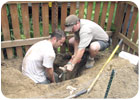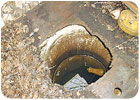
Today we are seeing much emphasis being placed on proper grouting techniques and materials; however, an issue of at least equal importance is that of sealing unused water wells.
In most cases, unused wells are domestic wells that no longer provide water to the homes for which they were drilled or dug; in other words, they have been abandoned. Other examples include wells that no longer serve a purpose, such as exploratory or monitoring wells, or wells that need repairs that are not economically feasible. These wells should be properly sealed when a replacement well is drilled.
Some of the reasons for properly sealing unused wells are the same as those regarding proper grouting of wells.
Physical hazard considerations –The most obvious reason for sealing abandoned water wells is the physical hazard they present to the public. A good example of this danger was seen in 1987 as the nation witnessed the rescue of a small girl from an abandoned water well in Texas. The well in this case was less than 10 inches in diameter. Many domestic wells fall within the 5-inch to 8-inch diameter range, posing a potential for a similar disaster. Other physical hazards include small animals falling into these wells. Using a downhole camera, there have been cases where small animal skeletons (rabbit-sized) were found at the bottom of unused wells, thus explaining the reason for an unsafe water samples in the unused wells, as well as in nearby wells that were in use.
Prevention of surface water contamination –Unsafe water samples also can result when surface contaminants have entered an aquifer through an improperly abandoned well. This situation often occurs when a drilling contractor is called in to diagnose a water supply problem. Upon investigating, the drilling contractor finds that reconditioning the old well would cost more than drilling a completely new well. After getting the owner’s OK, he moves over several feet from the old well and drills the new one. The contractor then proceeds to dump the cuttings from the drilling procedure down the old well to “seal” it. In these circumstances, the new well will not produce a safe sample, because the nearby old well was improperly sealed, and provides a direct path for surface contaminants to enter the aquifer.
Prevention of intermixing of water between aquifers –Proper well abandonment is a must in the case of a multi-aquifer system where the water quality is different in each aquifer. For example, if the upper aquifer is contaminated and is not sealed through the restrictive or confining layer, the potential exists for contamination of the lower aquifer. Contamination occurs because the natural restrictive barrier has been pierced and, if left open, will render the lower aquifer unusable because the poorer quality water in the upper aquifer will be able to migrate downward into the lower aquifer.
Preservation of hydrogeologic conditions – Another reason for properly sealing abandoned wells is to restore an aquifer to its original hydrogeologic condition. For example, in a region where artesian pressure predominates, abandoned wells left unsealed or improperly sealed will cause the hydrostatic pressure to drop due to the unchecked flow of water to the surface. This condition may be evidenced by wells that have persistently flowed for years, and now have recently stopped flowing. The possibility for regional pressure loss from improperly sealed wells exists where a lower confined aquifer is discharging water to an upper aquifer or to the surface. This water could be of substandard quality.
Prevention of direct disposal of contamination down unused wells –Because of the high cost of disposal, some unscrupulous companies or individuals might dispose of chemical wastes down unused wells if given the opportunity. Permanently plugging unused wells makes them inaccessible for illegal disposal.

Well Sealing Procedures
Like grouting, many procedures and different types of materials can be used to seal an unused well.Remove all equipment, such as pumps, pressure lines, etc., that may obstruct the placement and performance of the sealing agent.
An attempt should be made to remove screens, casings and liners, although, in many instances, this may be difficult or impossible. If possible, the casing and/or liner should be slit, perforated or ripped to allow the sealing agent to make the best possible seal.
If the casing cannot be pulled, it should be cut off below ground level. The depth at which the casing should be cut will depend on whether the well was classified as public or private; in most cases, 4 feet will be sufficient.
Ideally, the material used in sealing an abandoned well should reflect the surrounding geologic formations. Unfortunately, in most instances, the formations or their exact depths may not be known. Therefore, it often is hard to match the materials that should be used to the various formations. Many types of suitable materials are readily available for sealing abandoned wells. For best results, a bentonite clay should be placed in the well from the bottom up to the surface using a tremie pipe. As the well borehole is filled, the tremie pipe should be moved upward until the entire borehole is sealed. This helps to prevent bridging of the sealing agent, which can occur when the sealing material is poured into the well. Some other acceptable sealing materials include neat cement or a combination of neat cement and bentonite.
The location of the abandoned well and the specifics of the sealing procedure should be recorded and then reported to any and all appropriate agencies. ND
This article is provided through the courtesy of the Ohio Department of Natural Resources.
Report Abusive Comment